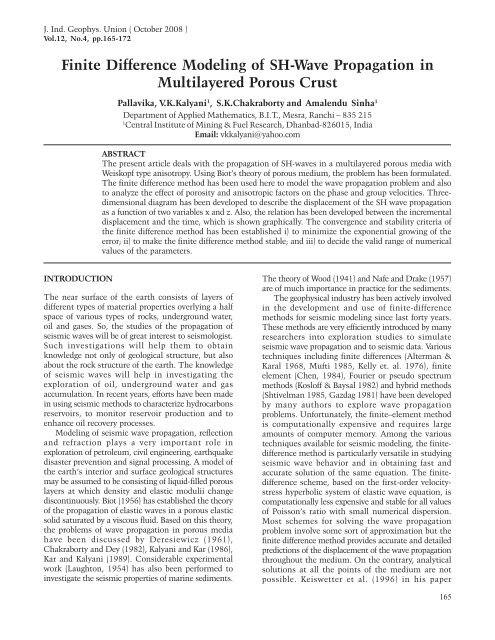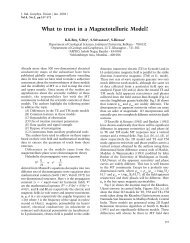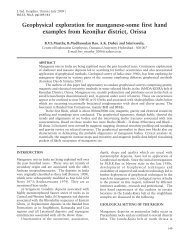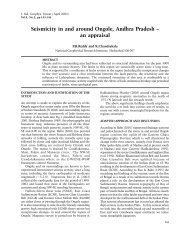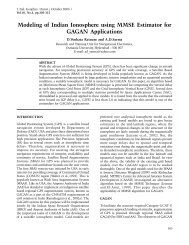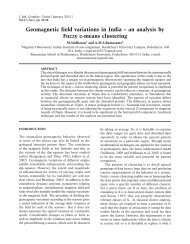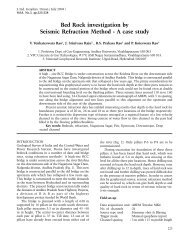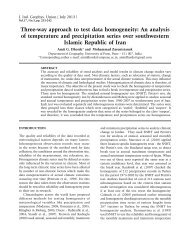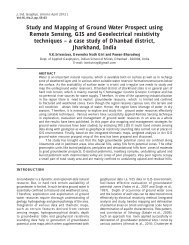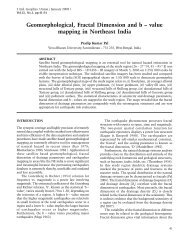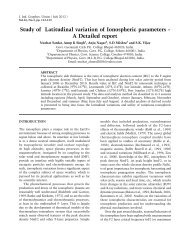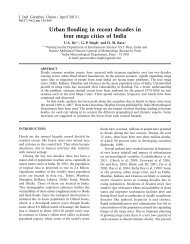Pallavika, V.K.Kalyani1, S.K.Chakraborty and Amalendu Sinha1 - IGU
Pallavika, V.K.Kalyani1, S.K.Chakraborty and Amalendu Sinha1 - IGU
Pallavika, V.K.Kalyani1, S.K.Chakraborty and Amalendu Sinha1 - IGU
Create successful ePaper yourself
Turn your PDF publications into a flip-book with our unique Google optimized e-Paper software.
J. Ind. Geophys. Union ( October 2008 )Vol.12, No.4, pp.165-172Finite Difference Modeling of SH-Wave Propagation inMultilayered Porous Crust<strong>Pallavika</strong>, V.K.Kalyani 1 , S.K.<strong>Chakraborty</strong> <strong>and</strong> <strong>Amalendu</strong> <strong>Sinha1</strong>Department of Applied Mathematics, B.I.T., Mesra, Ranchi – 835 2151Central Institute of Mining & Fuel Research, Dhanbad-826015, IndiaEmail: vkkalyani@yahoo.comABSTRACTThe present article deals with the propagation of SH-waves in a multilayered porous media withWeiskopf type anisotropy. Using Biot’s theory of porous medium, the problem has been formulated.The finite difference method has been used here to model the wave propagation problem <strong>and</strong> alsoto analyze the effect of porosity <strong>and</strong> anisotropic factors on the phase <strong>and</strong> group velocities. Threedimensionaldiagram has been developed to describe the displacement of the SH wave propagationas a function of two variables x <strong>and</strong> z. Also, the relation has been developed between the incrementaldisplacement <strong>and</strong> the time, which is shown graphically. The convergence <strong>and</strong> stability criteria ofthe finite difference method has been established i) to minimize the exponential growing of theerror; ii) to make the finite difference method stable; <strong>and</strong> iii) to decide the valid range of numericalvalues of the parameters.INTRODUCTIONThe near surface of the earth consists of layers ofdifferent types of material properties overlying a halfspace of various types of rocks, underground water,oil <strong>and</strong> gases. So, the studies of the propagation ofseismic waves will be of great interest to seismologist.Such investigations will help them to obtainknowledge not only of geological structure, but alsoabout the rock structure of the earth. The knowledgeof seismic waves will help in investigating theexploration of oil, underground water <strong>and</strong> gasaccumulation. In recent years, efforts have been madein using seismic methods to characterize hydrocarbonsreservoirs, to monitor reservoir production <strong>and</strong> toenhance oil recovery processes.Modeling of seismic wave propagation, reflection<strong>and</strong> refraction plays a very important role inexploration of petroleum, civil engineering, earthquakedisaster prevention <strong>and</strong> signal processing. A model ofthe earth’s interior <strong>and</strong> surface geological structuresmay be assumed to be consisting of liquid-filled porouslayers at which density <strong>and</strong> elastic modulii changediscontinuously. Biot (1956) has established the theoryof the propagation of elastic waves in a porous elasticsolid saturated by a viscous fluid. Based on this theory,the problems of wave propagation in porous mediahave been discussed by Deresiewicz (1961),<strong>Chakraborty</strong> <strong>and</strong> Dey (1982), Kalyani <strong>and</strong> Kar (1986),Kar <strong>and</strong> Kalyani (1989). Considerable experimentalwork (Laughton, 1954) has also been performed toinvestigate the seismic properties of marine sediments.The theory of Wood (1941) <strong>and</strong> Nafe <strong>and</strong> Drake (1957)are of much importance in practice for the sediments.The geophysical industry has been actively involvedin the development <strong>and</strong> use of finite-differencemethods for seismic modeling since last forty years.These methods are very efficiently introduced by manyresearchers into exploration studies to simulateseismic wave propagation <strong>and</strong> to seismic data. Varioustechniques including finite differences (Alterman &Karal 1968, Mufti 1985, Kelly et. al. 1976), finiteelement (Chen, 1984), Fourier or pseudo spectrummethods (Kosloff & Baysal 1982) <strong>and</strong> hybrid methods(Shtivelman 1985, Gazdag 1981) have been developedby many authors to explore wave propagationproblems. Unfortunately, the finite–element methodis computationally expensive <strong>and</strong> requires largeamounts of computer memory. Among the varioustechniques available for seismic modeling, the finitedifferencemethod is particularly versatile in studyingseismic wave behavior <strong>and</strong> in obtaining fast <strong>and</strong>accurate solution of the same equation. The finitedifferencescheme, based on the first-order velocitystresshyperbolic system of elastic wave equation, iscomputationally less expensive <strong>and</strong> stable for all valuesof Poisson’s ratio with small numerical dispersion.Most schemes for solving the wave propagationproblem involve some sort of approximation but thefinite difference method provides accurate <strong>and</strong> detailedpredictions of the displacement of the wave propagationthroughout the medium. On the contrary, analyticalsolutions at all the points of the medium are notpossible. Keiswetter et al. (1996) in his paper165
<strong>Pallavika</strong> et al.presented entire computer program (FDMODEL) basedon finite-difference techniques to approximate thesolution of the two-dimensional acoustic,heterogeneous wave equation. This program usesexplicit approximations of second-order accuracy forboth the spatial <strong>and</strong> temporal sampling intervals, <strong>and</strong>energy-absorbing boundary conditions.In the present work, Biot’s theory of porous mediahas been used to formulate the problem. Also, finite–difference method is applied to calculate group <strong>and</strong>phase velocities of SH-wave propagation in amultilayered porous medium for different values ofanisotropy <strong>and</strong> porosity parameters of the medium.The stability criteria are established for the finitedifference approximation in time <strong>and</strong> space forexistence of pure SH-wave propagation. It alsominimizes the exponential growth of the error withtime to make the finite difference scheme stable <strong>and</strong>convergent.FORMULATION OF THE PROBLEMLet us consider a liquid-saturated anisotropic porouscrust consisting of (n-1) parallel layers overlying a halfspace,as shown in Fig.1. The layers are numberedserially, the layer at the top being layer no.1 <strong>and</strong> thehalf space being layer no. n. The origin of a righth<strong>and</strong>edcartesian coordinate system (x, y, z) isconsidered at the free surface with the z-axis drawninto the half-space <strong>and</strong> the y-axis pointing positivelyfrom the plane of the paper towards the reader.The equations of motion in a liquid-filled porousmedium Biot (1956), are given by….(1)where τ xx, τ xy, … are the components of the stresstensor <strong>and</strong> T, the force exerted by the fluid on thefraction of an area of the unit cross section of theaggregate is related to the pressure p of the fluid by– T = βp,where β is the porosity of the layer. Here u x, u y<strong>and</strong>u zare the components of the displacement vector uof the solid <strong>and</strong> U x, U y<strong>and</strong> U zis that of liquid. Thecoefficients ρ 11, ρ 12, ρ 22are the mass coefficientsrelated to the mass of the solid ρ(s) <strong>and</strong> that of theliquid ρ(f), each measured per unit volume of theaggregate, by means ofρ(s) = ρ 11+ ρ 12, ρ(f) = ρ 12+ ρ 22<strong>and</strong>, moreover, obey the inequalitiesρ 11>0, ρ 22>0, ρ 120Also,ρ(s) = (1-β) ρ s<strong>and</strong> ρ(f) = βρ f,where ρ s<strong>and</strong> ρ fare the mass densities of the solid <strong>and</strong>the liquid, respectively; the mass density of theaggregate is given byFigure 1. Geometry of the problem166
Finite Difference Modeling of SH-Wave Propagation in Multilayered Porous Crustρ = ρ 11+ 2ρ 12+ ρ 22The stress strain relations for the liquid filled porousmedium are (Biot 1956, Weiskopf 1945) given by… (2)<strong>and</strong>T = Q e + Rθwhere e = Div u <strong>and</strong> q = Div U <strong>and</strong> A, N correspondto the familiar Lame coefficients in the theory ofelasticity <strong>and</strong> are positive. Moreover, the coefficientN represents the shear modulus of the material, thecoefficient R is a measure of the pressure on the liquidwhile the total volume remains constant.Furthermore, the coefficient Q characterizes thecoupling between the volume change of the solid <strong>and</strong>that of liquid.For the propagation of SH-waves parallel to the x-axis <strong>and</strong> z-axis pointing downwards,…accuracy of the numerical solutions can be increased.The mesh is the set of locations where the discretesolution is obtained <strong>and</strong> these points are also callednodes. The main idea of the finite–difference methodis to replace partial derivatives with difference formulasthat involve only the discrete values associated withpositions on the mesh. Fig.1 represents a verticalsection of a liquid-filled anisotropic porous crustconsisting of (n-1) parallel layers overlying a half-space.For the development of a finite difference model, afinite rectangular portion of the medium is considered<strong>and</strong> it is discretized by introducing a grid on the xzplane with equal increments of Δx <strong>and</strong> Δz along thex <strong>and</strong> z-axes respectively. Also, Δt is the measure ofdiscretization in time. By applying finite differencemethod, one can obtain an approximate solution forv (x, z, t) at a finite set of x, z <strong>and</strong> t. For thedevelopment of the method, time-space grid is takenas,x m= mΔx, m = 0,1,2, …,Mz n= nΔz, n = 0,1,2, …, Nt l= lΔx, l = 0,1, 2, …, LUsing the notationv l m, n = v(x m , z n , t l )<strong>and</strong> applying Taylor series for the expansion of v l m+1,n<strong>and</strong> v l m-1,n respectively, ..(5)(3)Thus, the equation of motion in the m th layer isgiven by<strong>and</strong>… (4)..(6)in whichone obtains by subtracting (6) from (5):, m = 1, 2, …, n...(7)FINITE DIFFERENCE APPROACHThe finite difference is one of the most importantmethods to solve wave equation numerically. In finitedifference scheme, the partial differential equation isreplaced with a discrete approximation <strong>and</strong> thenadvancing the solution in time domain to get theaccurate solution. The word “discrete”, comes fromthe 15th Century Latin word discretus, is defined asa finite number of points in the domain. Increasingthe number of mesh points in the domain, thethis gives..(8)This can also be expressed as… (9)Assuming Δx small, central differenceapproximations of is formed as167
<strong>Pallavika</strong> et al.… (10)Instead of using the wave equation, which is asecond order hyperbolic system, the elastodynamicequations are given by,… (11)The above equations can be transformed into thefollowing first-order hyperbolic system:...… (12)Stability AnalysisWhen the finite difference approximation is used tosolve the equation of motion of seismic wavepropagation in the time domain, the stability criteriamust be satisfied <strong>and</strong> the finite difference schemeapplied must be convergent <strong>and</strong> stable. By stability,one means that errors made at one stage ofcalculations do not cause increasingly large errors asthe computations progress, but rather error dies out.Also by convergent one means that the results of themethod approach the analytical results as Δt <strong>and</strong> Δxapproach zero. Many authors (Cao & Greenhalgh1998, Mitchell 1969) have developed stability fordifferent finite difference approximations The stabilitycondition obtained for the finite difference scheme(13), using the initial error in α, β <strong>and</strong> ν.at t = 0, isfound to bewhere,..(14)The central finite-difference scheme developed in(10) is used to discretize the derivatives of thesegoverning equations. Thus, the explicit numericalscheme, equivalent to the system (12), is given by. .. .. .… (13)where l is the index for time discretization, m for x-axis discretization, <strong>and</strong> n for z-axis discretization. Δtis the grid step in time, Δx <strong>and</strong> Δz are the grid stepsfor the x-axis <strong>and</strong> for the z-axis, respectively.Initial <strong>and</strong> Boundary ConditionsUnder the initial conditions both stress <strong>and</strong> velocityare zero everywhere in the medium at time t = 0 tomake the medium in equilibrium (Virieux 1986).Boundary conditions considered here are the Neumanncondition (stress-free conditions) <strong>and</strong> the Dirichletcondition (zero velocity or zero displacementconditions).For the finite difference scheme (13) to be stableshould be always less than or equal to 1.Consequently, ω will be real, <strong>and</strong> the error will notgrow with time. Thus, the condition for stability isto make the time-mesh interval Δt smaller than orequal to , where is the local wavevelocity for Δx = Δz.The stability condition (14) also gives the relationbetween frequency <strong>and</strong> wave number k to be satisfiedby the solution. The phase <strong>and</strong> group velocitiesdetermined by (14) approach the correct local valuesif Δt, Δx <strong>and</strong> Δz are small. Also, for small Δt, Δx <strong>and</strong>Δz one can approximate Sinθ by θ <strong>and</strong> obtain, from(14),… (15)It is important to know that how small Δx <strong>and</strong>Δz should be so that the above relation isapproximately correct. The limit depends on thewavelength ,. Rewriting (14), the phase velocityis given by..(16)168
Finite Difference Modeling of SH-Wave Propagation in Multilayered Porous Crustin which, k = r <strong>and</strong> Δx = Δz. The correspondinggroup velocity, the rate at which energy is transported,is given by… (17)NUMERICAL RESULTS AND DISCUSSIONSThe numerical values of the phase velocities <strong>and</strong> groupvelocities have been computed from equations (16) <strong>and</strong>(17) respectively in non-dimensional form ω/k <strong>and</strong> δw/δk for different values of dispersion parameter Δx/λfor SH wave propagation in a layer overlying a halfspace.Fig. 2 depicts the effect of variations ofanisotropic parameter N/G on the phase velocity inFigure 2. Variations of Phase Velocity with DispersionParameter when γ=1 <strong>and</strong> N/G=1, 1.5, 1.75 in Layer.Figure 3. Variations of Phase Velocity with DispersionParameter when N/G=1 <strong>and</strong> γ=1 , 1.5, 2.0 in Layer.Figure 4. Variations of Phase Velocity with DispersionParameter when γ=1 <strong>and</strong> N/G=1 , 1.5, 1.75 in halfspace.Figure 5. Variations of Phase Velocity with DispersionParameter when N/G=1 <strong>and</strong> γ=1, 1.5, 2.0 in halfspace.169
<strong>Pallavika</strong> et al.Figure 6. Variations of Group Velocity with DispersionParameter when γ=1 <strong>and</strong> N/G=1, 1.5, 1.75 in Layer.Figure 7. Variations of Group Velocity with DispersionParameter when N/G=1 <strong>and</strong> γ=1, 1.5, 2.0 in Layer.Figure 8. Showing displacement as a function of x<strong>and</strong> zFigure 9. Showing displacement as a function oftimethe layer with the increase in dispersion parameter Δx/λ, which indicates that the phase velocity increaseswith the increase in dispersion parameter <strong>and</strong> attainsa maximum when the value of dispersion parameterDx/l is nearer to 0.3 <strong>and</strong> thereafter decreases with theincrease in the dispersion parameter for all values ofN/G. From Fig. 3, it is observed that, the phasevelocity in the layer first increases <strong>and</strong> attains itsmaximum for all values of porosity parameter γ(Kalyani et. al., 1986). On the other h<strong>and</strong>, the phasevelocity also decreases with the increase in dispersionparameter for all values of porosity parameter γ. InFig 4 the variations of phase velocity with dispersionparameter in the half space indicate that the phasevelocity increases with the increase in dispersionparameter, <strong>and</strong> attains maximum <strong>and</strong> then decreasesfor all values of N/G. From fig. 5, it is observed thatthe phase velocity in the half space first increasesattains maximum <strong>and</strong> then decreases with theincreases in dispersion parameter for all values ofporosity parameter. In the Figs.2-5, it is interestingto note that all the curves in the figures areintersecting at some point when the dispersionparameter is nearer to 0.5.170
Finite Difference Modeling of SH-Wave Propagation in Multilayered Porous CrustFigs. 6-7 show the variations of group velocity asa function of dispersion parameter for different valuesof anisotropic factor <strong>and</strong> porosity parameter. Fromthese figures, it can be concluded that the groupvelocity in the layer depend not only on dispersionparameter but also on anisotropic factor N/G <strong>and</strong>porosity parameter γ. Fig. 8 is developed using thesoftware MATLAB showing the three dimensional viewof the displacement of the SH wave propagation as afunction of two variables x <strong>and</strong> z. Fig.9 depicts thedisplacement as a function of time, which indicatesthat the curve is oscillating when the time is inbetween 0 <strong>and</strong> 0.02 for all values of porosity parameter.CONCLUSIONSThe finite difference scheme is a straightforward<strong>and</strong> practical way of solving a number of pertinentseismological problems. The essence of thistechnique is to replace the differential equations<strong>and</strong> boundary conditions by simple finite differenceapproximations in such a way that an explicit,recursive set of equations is formed. The finitedifference method offers a most direct path fromthe problem formulated in terms of basic equations,initial <strong>and</strong> boundary conditions to the digitalcomputers, for solution with a minimum ofanalytical effort. The above findings can be used inthe interpretation <strong>and</strong> simulation of geophysicaldata. Moreover, the same can be implemented inforecasting formation details.REFERENCESAlterman, Z. & Karal, F., 1968. Propagation of elastic wavesin layered media by finite differences methods, Bull.Seismo. Soc. Amer. 58, 367–398.Biot, M.A., 1956. Elastic waves in porous solids, Int. J.Acoust. Soc. Am., 28, 168-178.Cao, S. & Greenhalgh, S., 1998. 2.5D modeling of seismicwave propagation: Boundary condition, stabilitycriterion, <strong>and</strong> efficiency, Geophysics, 63, 2082-2090.<strong>Chakraborty</strong>, S.K. & Dey, S., 1982. The propagation of Lovewaves in water- saturated soil underlain by aheterogeneous elastic medium, Acta Mechanica, 44,169-176.Chen, K., 1984. Numerical modeling of elastic wavepropagation in anisotropic inhomogeneous media: afinite element approach (ext. abst), Soc. Expl.Geophys., 54 th Intern. Mtg., 631-632.Deresiewicz, H., 1961. The effect of boundaries on wavepropagation in a liquid-filled porous solid II, Lovewaves in porous layer, Bull. Seismol. Soc. Amer. 51(1),51-59.Gazdag, J., 1981. Modeling of the acoustic wave equationwith transform methods, Geophysics, 46(6), 854-859.Kalyani, V.K. & Kar, B. K., 1986. Propagation of Love Wavesin a water-saturated soil lying between two semiinfinitehomogeneous elastic media, Acta GeophysicaPolonica, XXXIV (4), 349-359.Kar, B. K. & Kalyani, V.K., 1989. Dispersion of Love wavesin a multi-layered anisotropic porous crust, Gerl<strong>and</strong>sBeitr. Geophysik. Leipzig, 98(2), 131-137.Keiswetter, D., Black, R. & Schmeissner, C., 1996. Aprogram for seismic wavefield modeling using finitedifferencetechniques, Computers & Geoscience,22(3),267-286.Kelly, K. R., Ward, R.W., Treitel, S. & Alford, R., 1976.Synthetic seismograms, a finite-difference approach,Geophysics, 41, 2–27.Kosloff, D. & Baysal, E., 1982. Forward modeling by aFourier method, Geophysics, 47 (10), 1402-1412.Laughton, A. S., 1954. Laboratory measurements of seismicvelocities in ocean sediments, Proc. Roy Soc., London,Ser. A, 222, 336-341.Mitchell, A.R., 1969. Computational methods in partialdifferential equations, John Wiley & Sons, Inc.Mufti, I.R., 1985. Seismic Modeling in the implicit mode,Geophysical prospecting, 33, 619-656 (1985)Nafe, J.E. & Drake, C.L., 1957. Variation with depth inshallow <strong>and</strong> deep water marine sediments of porosity,density <strong>and</strong> the velocities of compressional <strong>and</strong> shearwaves, Geophysics, 22, 523-552.Shtivelman, V., 1985. Two–dimensional acoustic modelingby a hybrid method, Geophysics, 50(8), 1273-1284.Virieux, J., 1986. P-SV wave propagation in heterogeneousmedia: Velocity-stress finite-difference method,Geophysics, 51, 889-893.Weiskopf, W.H., 1945. Stresses in soils under foundation,J. Franklin Inst., 239, 445.Wood, A.B., 1941. A Text Book of Sound, G. Bell <strong>and</strong> Sons,London.Ms. <strong>Pallavika</strong>, presently pursuing her Ph.D in Applied Mathematics from Birla Institute ofTechnology, Mesra, Ranchi. She has done her post graduation in Mathematics from UtkalUniversity, Orissa. She has successfully completed two years CSIR Diamond Jubilee ResearchIntern in Central Institute of Mining <strong>and</strong> Fuel Research, Dhanbad. Her field of interest ismathematical modeling, computer simulation <strong>and</strong> mathematical seismology. Presently sheis developing finite difference techniques for modeling of seismic wave propagation forsimulation of geophysical structure. She has five publications to her credit, mostly researchpapers published in national <strong>and</strong> international journals.171
<strong>Pallavika</strong> et al.Dr. V.K. Kalyani, is working as a senior scientist in Information Technology Division of CentralInstitute of Mining & Fuel Research, Dhanbad. He has done his Master's Degree from BirlaInstitute of Technology, Mesra, Ranchi <strong>and</strong> M.Phil, M.Tech (Computer Applications) <strong>and</strong> Ph.D(Applied Mathematics) from Indian School of Mines University, Dhanbad. Dr. Kalyani is arecipient of Gold Medal of Indian School of Mines, Dhanbad for excellence in M.Phil course.His field of interest is mathematical modeling <strong>and</strong> software development in the area of processdesigning <strong>and</strong> optimization. Presently, he is working in the area of neural network modeling<strong>and</strong> seismic wave propagation. He has forty publications to his credit, mostly research paperspublished in national <strong>and</strong> international journals as well as symposia/conferences <strong>and</strong>proceedings. He is the past secretary <strong>and</strong> member of CSI Dhanbad Chapter. He has guidedquiet number of M.Phil <strong>and</strong> M.Tech students of different universities. He is very often invitedas guest faculty for specialized lecture <strong>and</strong> resource personal in various universities.Dr. Swapan Kumar Chakarborty graduated with a B.Sc. degree <strong>and</strong> an M.Sc. degree inMathematics from the Indian Institute of Technology, Kharagpur, India. He completed his PhD programme in the Indian School of Mines, Dhanbad, India. His fields of interest includeSeismology, Rock Mechanics, Structural Dynamics <strong>and</strong> Heat Transfer. He has published a goodnumber of research papers in international journals <strong>and</strong> conference proceedings (international/ national). He possesses extensive <strong>and</strong> distinguished teaching experience. He also worked inR&D organization. Presently he is reader in the Department of Applied Mathematics, BirlaInstitute of Technology, Mesra, Ranchi, India.172Dr. <strong>Amalendu</strong> Sinha (born on July 5, 1955) obtained M.Sc. in Applied Geology with First Classin 1976 <strong>and</strong> M.Sc.(Tech) First Class, in Mineral Exploration in 1977 <strong>and</strong> did his Ph.D. inApplied Geology in 1988 from Indian School of Mines, Dhanbad, a pioneer Institution in thefield of Mining Sciences in India <strong>and</strong> abroad. Dr. Sinha joined CMRI in 1977 as Scientist 'B'<strong>and</strong> gradually elevated to the position of Scientist 'G' by virtue of his keenness, devotion <strong>and</strong>dedication to R&D in the areas of Geo-mechanics <strong>and</strong> Mining Technology.His areas of research cover Development & Application of Geo-Mechanical Classification Systemfor Support Design in Coal Mine Roadways; Evaluation of In-situ Stress Field for StabilityAnalysis; In-situ Stress Measurement in Underground Coal Mines <strong>and</strong> its Applications toStability Analysis <strong>and</strong> Assessment of Ground Behaviour <strong>and</strong> Stability for Planning <strong>and</strong> Designof Non-coal Mines. He has coordinated <strong>and</strong> guided a number of R&D Projects, industrysponsored projects, grants-in-aid projects in the field of mining technology, geo-environment,coal-bed methane, blasting <strong>and</strong> explosive. In addition to these, he also completed successfullya good number of consultancy projects sponsored by the Industry.Dr. Sinha has large number of research papers published in the journals of repute in India<strong>and</strong> abroad <strong>and</strong> presented in different National & International Conferences. He also edited afew proceedings <strong>and</strong> has some patents to his credit. Dr. Sinha has carved out a niche in thefield of his areas of research <strong>and</strong> is well known scientist in the field of mining sciences ingeneral <strong>and</strong> geo-mechanics in particular. Dr. Sinha is a member of Academic Council of IndianSchool of Mines, Dhanbad He also represents CMRI as a member in a number of committeesconstituted by different Government Organizations <strong>and</strong> Academic Institutions <strong>and</strong> Industriesin the country. He has been elected as a Council Member of the prestigious institution 'TheMining, Geological & Metallurgical Institute of India' for the terms 2007-08, 2008-09 & 2009-10.Dr. Sinha became Acting Director on <strong>and</strong> from 29.7.2005 of erstwhile CMRI <strong>and</strong> afterconsolidation of both erstwhile CMRI <strong>and</strong> CFRI in their consolidated new entity as CentralInstitute of Mining <strong>and</strong> Fuel Research (CIMFR), he has taken over as Acting Director witheffect from 04.5.2007. Dr. Sinha is member of the pioneer professional bodies like MiningGeological & Metallurgical Institute of India (MGMI), Indian Geo-technical Society (IGS),International Society of Rock Mechanics & Tunneling Technology, (ISRMTT) etc. He is a fellowof the Institution of Engineers (India) & Indian Geophysical Union. Dr .Sinha visited ondeputation/assignment to various countries like USA, Germany, Czech Republic Iran <strong>and</strong>Canada. In November 12-13, 2007, he attended a Workshop on International Exchange ofExperience in Underground Coal Gassification Technologies in Almaty, Kazakhstan organizedby Department of Economic <strong>and</strong> Social Affairs, Division of Sustainable Development, UnitedNations, New York.


